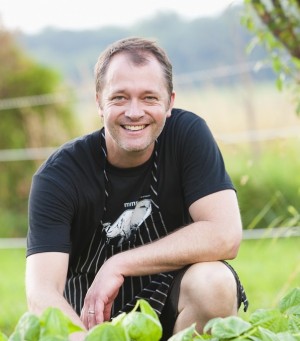2013 James Beard Awards Spotlight: Chef Paul Virant Cooks Up ‘Perennial’ Influence Using Canning, Preservation and Seasonal Ingredients
GALO: The black-and-white elegant, upscale décor pervading your Vie restaurant is appealing. The framed portraits, white tablecloths and glassware exude an unassuming opulence without a pretentious air (one that could be assumed when you learn Vie has a smart casual dress code). With Vie garnering five stars from the Chicago Tribune, how important is the ambience including the lighting, seating and menu presentation to your restaurant’s success?
PV: I describe [the ambience] as casual elegant. A lot of the atmosphere is based on 19th century Europe, so there are a lot of antique scones from Italy and tufted banquettes; I think that is what adds the elegance. The menu and style of service helps create that comfortable atmosphere so it is casual. And back to the community aspect, all the black and white shots were done by a student, Jen Yu Wang… It was all choreographed with the style of the restaurant, and the shots captured the different seasons. It’s funny how the atmosphere of a restaurant ultimately creates or determines the kind of restaurant that it is. I am a casual person. It is a little more interesting on the elegant side because of the décor, the granite, and everything about the look of the place.
GALO: Speaking of success, let’s say that your favorite chef challenged you to a cook-off. Since you have experience in this area given your participation in the television show Iron Chef America, and you have an ingredients-driven approach to cooking, how would you go about tackling this challenge? And with such a time crunch working against the clock, how would you overcome that pressure?
PV: One of my acquaintances is Paul Kahan, of [the restaurants] Blackbird and Publican; he is a big star. To some extent, we both have a similar underlying style of cooking. The interesting thing is that he and I are doing a dinner at a house with one other chef and a mixologist for a fundraiser in a few weeks. We have done this before and in this case, it’s not a competition. But we both are obviously looking to do things that are going to represent ourselves well. Ideally, with the guest of the house, I would not want them to say, “you know what Paul Kahan made is better than what you made.” In a way, it is almost like an unwritten or unspoken competition. You want to make sure what you are doing is going to be solid. Honestly, doing what I do, including being on Iron Chef, we didn’t change anything that we do or anything that we are all about. I would take the same approach; I figure that getting into a competition [and] being comfortable with what you know is the best way to approach that. It is not the time to try to reinvent the wheel.
Our cooking is always very seasonal. Ramps are coming into season right now; those are the wild onions that are found in the forest. [Ramps] would definitely be a huge focus of the menu. Also, some lamb maybe; it is something that we do a lot in the springtime.
GALO: It can be a daunting challenge to learn how to make new dishes, especially those with international roots. Are there any cuisines that you want to study in the near future and why?
PV: I am always learning because [international cuisines] are quite a bit different from what we are cooking daily. I am always interested in Asia, which encompasses a lot of different countries. Also, it could be India. Even within India, there’s a vast difference [from what we cook] depending on the part of the country. I’m always interested in North African and Middle Eastern [cuisines]. Having an opportunity to do more traveling would be a great way to pursue some of these things.
Japanese food is something that I am always interested in. I think you crave what you are not exposed to much. When my wife and family go out to eat, that is the kind of food we are looking to have: something different and something ethnic.

Featured image: Chef Paul Virant in his garden. Photo Credit: © 2011 Jeff Kauck Photography.

